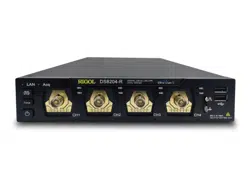Loading ...
Loading ...
Loading ...

RIGOL Chapter 5 To Trigger the Oscilloscope
5-40 DS8000-R User Guide
parameters:
➢ Click Bit X to set the data bit that needs to be operated on. For setting
methods, refer to descriptions in "I2C Trigger (Option)".
➢ Click Bytes, then use the numeric keypad or scroll with the mouse to set
the length of the data. Its range is from 1 to 8.
⚫ Data&ID: triggers on the data frames with the specified ID and data. Set the
following parameters:
➢ Click Define to select "Data" or "ID".
➢ When you select "Data", set Bit X and Bytes. For detailed settings, refer to
parameter settings for "Frame Data".
➢ When you select "ID", set Extended ID and Bit X. For detailed settings,
refer to parameter settings for "Frame ID".
⚫ Frame Error: triggers on the error frame.
⚫ Bit Fill: triggers on the error frame with the bit fill.
⚫ Answer Error: triggers on the answer error frame.
⚫ Check Error: triggers on the check error frame.
⚫ Format Error: triggers on the format error frame.
⚫ Random Error: triggers on random error frame, such as the format error frame,
answer error frame, etc.
Signal Type:
Click More → Signal Type to select the desired signal type.
⚫ CAN_H: indicates the actual CAN_H bus signal.
⚫ CAN_L: indicates the actual CAN_L bus signal.
⚫ TX/RX: indicates the Transmit signal and Receive signal from the CAN bus
transceiver.
⚫ DIFF: The CAN differential bus signals connected to an analog source channel by
using a differential probe. Connect the probe's positive lead to the CAN_H bus
signal and connect the negative lead to the CAN_L bus signal.
Baud Rate:
Click More → Baud to set the baud rate. The following setting methods are
available for baud rate:
⚫ Click Baud, then set the user-defined baud rate with the displayed numeric
keypad or by scrolling with the mouse.
⚫ Click Baud, then select the preset baud rate from the available options. The
available baud rates include 10 kbps, 20 kbps, 33.3 kbps, 50 kbps, 62.5 kbps,
83.3 kbps, and etc.
Sample Position:
Sample position is a point within a bit’s time. The oscilloscope samples the bit level at
this point. The sample position is represented by the proportion of "the time from the
start of the bit to the sample position" to the "bit time", as shown in the figure below.
Loading ...
Loading ...
Loading ...
